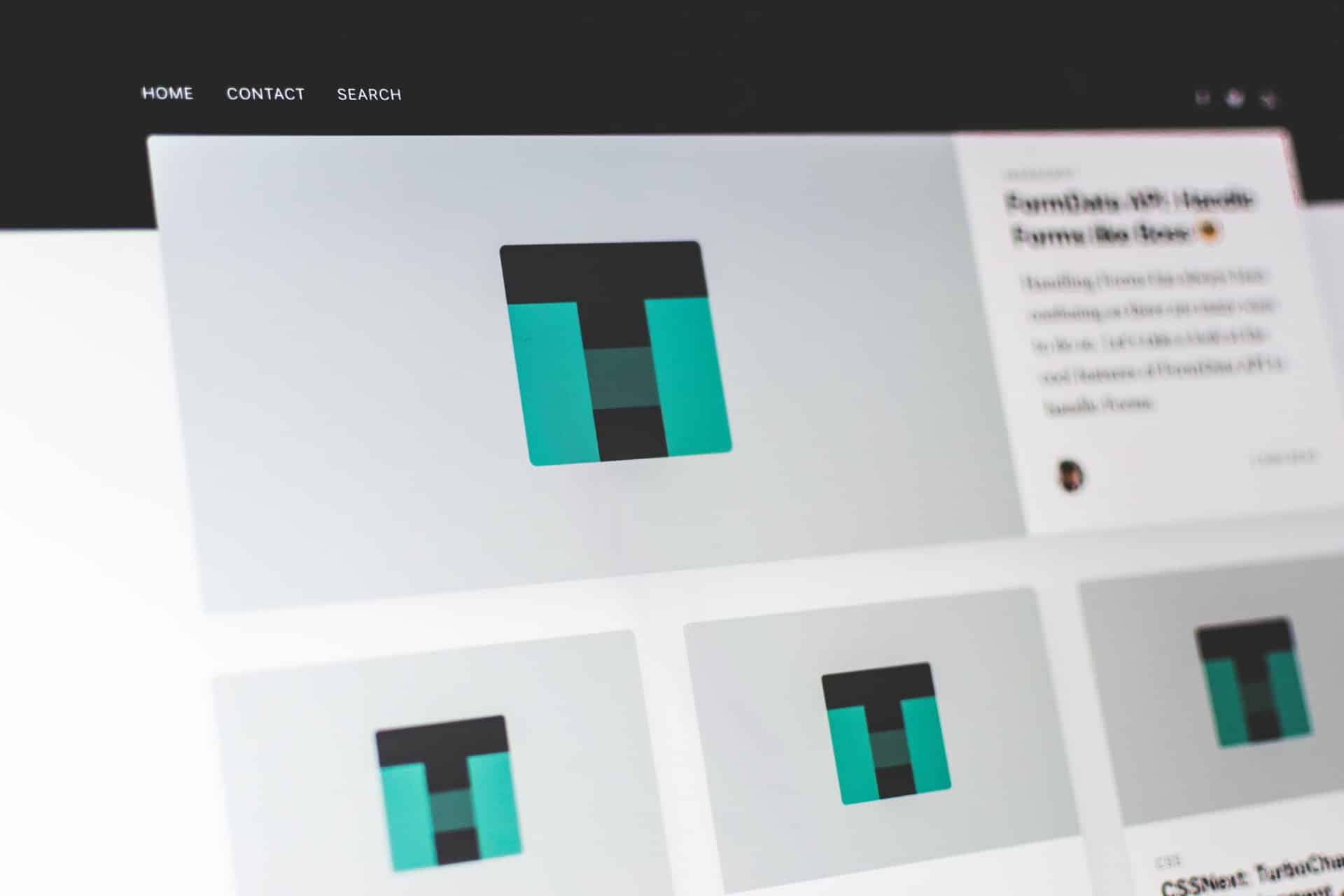C'est grâce aux moteurs de recherche comme Google que beaucoup d'entre nous trouvent des réponses rapides à des questions telles que la recherche de services, de restaurants, de produits ou de tutoriels à proximité. D'après Hitwise, les recherches sur mobile représentent environ 60% de tous les volumes de recherche.
Cette statistique met en lumière l'importance d'un site web adapté aux besoins des utilisateurs mobiles. L'expérience des sites web est de plus en plus riche, car de plus en plus de personnes accèdent aux sites web sur leurs téléphones et leurs tablettes.
Votre portfolio de photographie numérique doit non seulement être attrayant sur un ordinateur de bureau, mais il doit également offrir une expérience mobile transparente. Les entreprises qui ne mettent pas en place une conception de site web adaptée aux mobiles risquent de perdre des clients au profit de concurrents et de nuire à leur trafic sur les moteurs de recherche.
Alors, comment créer un beau site web adapté aux mobiles, optimisé et réactif ?
Il peut être difficile de s'y retrouver, c'est pourquoi nous avons consacré cet article à souligner pourquoi l'optimisation mobile est importante et à vous donner des conseils pour utiliser les modèles de sites afin de créer une page d'atterrissage réactive pour votre entreprise sans avoir besoin d'apprendre le HTML5 ou le CSS.
Qu'est-ce que le Responsive Web Design ?
Vous souvenez-vous de l'époque où vous pouviez pincer et zoomer une page web sur votre téléphone ?
Ce n'était pas une expérience agréable.
Il était difficile de lire le texte, c'était un cauchemar de naviguer et les temps de chargement des pages étaient insupportables.
La conception de sites web réactifs est la solution à la multitude de tailles d'écran et de résolutions disponibles pour accéder à l'internet. Elle centre vos éléments web sur l'expérience de l'utilisateur en fonction de son appareil en incorporant une technologie qui répond automatiquement. aux préférences de l'utilisateur.
Responsive Vs. Conception de sites web adaptatifs
Les développeurs utilisent essentiellement deux techniques pour concevoir des sites web adaptés aux mobiles-la conception réactive et adaptative.
Une mise en page réactive s'adapte à la taille du navigateur. Plus l'écran est petit, plus le contenu occupe l'espace vertical. Cette mise en page réactive est beaucoup plus fluide. Dans les conceptions entièrement réactives, vous pouvez considérer les éléments web comme de l'eau dans un récipient, ajustant sa forme pour s'adapter à son contenant.
La conception web adaptative ajuste la mise en page de vos informations en fonction d'une certaine largeur ou d'un point de rupture. Lorsque vous ajustez la taille du navigateur de votre site web sur un ordinateur de bureau, vous remarquerez que les éléments de la page snap à partir d'un seuil donné. L'avantage est que les temps de chargement des sites adaptatifs adaptés aux mobiles sont beaucoup plus rapides.
Il n'y a pas de réponse unique à la question de savoir ce qui est le mieux pour vous - tout dépend du contenu de votre site Web.
Cependant, l'un des plus grands avantages de l'utilisation d'un design web réactif est qu'il permet à votre contenu de s'adapter aux nouveaux appareils qui peuvent offrir des tailles et des résolutions différentes. En outre, il nécessite beaucoup moins de maintenance à long terme.
Heureusement, il n'est pas nécessaire de comprendre le langage HTML5 pour créer un site web entièrement réactif.

L'importance des sites web adaptés aux mobiles
Expérience de l'utilisateur
Ce n'est pas à votre visiteur de comprendre comment naviguer dans votre portfolio en ligne. C'est à vous de créer une expérience agréable et simple, quel que soit l'écran sur lequel il accède à votre page de destination.
Quand vous ignorez les principes du responsive design, vous risquez de perdre une grande partie des clients potentiels qui visitent principalement les sites sur leurs smartphones. La commodité est essentielle à l'heure où les gens semblent de plus en plus manquer de temps et être en déplacement.
L'expérience utilisateur est l'un des principaux éléments à prendre en compte lors de la création d'un site réactif. Grâce aux pages web réactives, vos clients potentiels peuvent naviguer sur votre site en toute transparence, quel que soit l'appareil qu'ils utilisent.
Si votre portefeuille est trop difficile à utiliser, vous obligez les visiteurs à préférer vos services à ceux d'un concurrent.
Classement Google / objectifs de référencement
Pour de nombreux professionnels de la création, un site web est un outil bien plus efficace qu'un CV traditionnel. Il peut également s'avérer un outil puissant pour la génération de prospects, avec le bon Optimisation des moteurs de recherche (SEO) stratégies.
L'optimisation des moteurs de recherche consiste à fournir aux utilisateurs les meilleures réponses possibles à leurs requêtes sur Google ou d'autres moteurs de recherche - une fois encore, il s'agit de créer la meilleure expérience utilisateur.
La réactivité mobile est un facteur important dans le classement de Google pour le référencement. Google pénalise les pages web qui offrent une mauvaise expérience mobile en diminuant vos chances d'apparaître dans les résultats de recherches pertinentes.
Un contenu adapté aux mobiles est plus facile à partager
Le partage de liens est un moyen essentiel de diffuser des informations et des idées.
Si vous partagez un lien vers votre site web depuis un ordinateur de bureau avec quelqu'un qui l'ouvre depuis un appareil mobile, cette personne peut avoir des difficultés à charger la page ou à naviguer pour obtenir les informations dont elle a besoin. L'utilisation d'un modèle de site réactif vous permet d'accroître la portée de votre marque sur tous les appareils.
Les sites web réactifs sont particulièrement importants lorsqu'un client potentiel demande à voir votre portfolio ou lorsqu'un collègue veut recommander votre travail à un client potentiel.
La technologie des tablettes et des téléphones étant de plus en plus accessible et facile à utiliser, il est probable que davantage de personnes ouvriront le lien vers votre portfolio sur un appareil portable plutôt que sur un ordinateur.
Assurez-vous de donner le meilleur de vous-même en veillant à ce que votre site soit beau et fonctionnel sur toutes les plateformes.
Mon site web actuel est-il adapté aux mobiles ?
Si vous ne savez pas si votre modèle de site web est adapté, il y a de fortes chances qu'il ne le soit pas. Voici deux méthodes simples, étape par étape, pour tester la réactivité mobile de votre site web.
La première méthode consiste à ouvrir votre site web sur un navigateur de bureau. Avec votre curseur, saisissez le côté droit de la fenêtre et faites-le glisser vers la gauche pour réduire la page à la taille d'un écran mobile.
Les sites réactifs redimensionnent automatiquement le contenu pour qu'il corresponde aux paramètres de la taille du navigateur. Si vous remarquez que le contenu de votre page web s'adapte à une autre disposition à une certaine largeur d'écran, vous savez que la conception du site est adaptative.
Quoi qu'il en soit, votre site web devrait occuper plus d'espace de défilement vertical à mesure que la fenêtre se rétrécit, et votre texte et vos images devraient rester faciles à lire.
Si la page semble se couper ou ne pas s'afficher correctement lorsque vous réduisez la fenêtre, il est possible que votre site web ne soit pas optimisé pour les tablettes ou les écrans de téléphone, et vous pouvez envisager des modèles réactifs.
La deuxième méthode pour vérifier si votre site web est optimisé pour les écrans de téléphone est beaucoup plus précise pour le référencement adapté aux mobiles.
Il suffit de se rendre sur le site Page de test de Google sur la convivialité mobile et entrez votre URL. Non seulement il déterminera si votre page est adaptée aux mobiles, mais il vous signalera les problèmes de chargement de page que vous devriez résoudre pour améliorer votre indexation dans les moteurs de recherche pour le référencement.
Que dois-je faire si mon site n'est pas adapté aux mobiles ?
Il n'existe pas de méthode unique pour rendre votre site web plus adapté aux mobiles, mais il existe une option simple et directe.
Plutôt que de créer un site web mobile distinct en plus de votre site de bureau original, vous pouvez utiliser des modèles qui intègrent des éléments adaptés à différentes résolutions et tailles d'affichage.
Il est désormais beaucoup plus facile de créer un site web adapté aux mobiles sans aucune expérience en matière de codage, en utilisant des modèles de sites web réactifs. créé par des développeurs qui connaissent HTML5 et CSS (pour que vous n'ayez pas à le faire). Ces modèles web sont faciles à utiliser et vous permettent de personnaliser la mise en page sans vous soucier de l'aspect technique de la conception.
Les membres de Format bénéficient d'un accès à plus de 70 services réactifs gratuits modèles de sites web adaptés aux mobiles facilement personnalisables dans les moindres détails, conçus pour les professionnels de la création.
Format vous permet d'alterner facilement entre vue mobile et vue de bureau lors de la conception de votre site, de sorte que vous puissiez vous assurer qu'il s'affiche correctement, quel que soit l'appareil à partir duquel votre client potentiel le consulte.
Travailler avec des modèles réactifs vous décharge d'une grande partie de la conception et du travail technique, ce qui signifie que vous pouvez avoir le site web de vos rêves et l'optimiser pour le référencement en quelques heures.

Meilleures pratiques pour un référencement adapté aux mobiles
C'est une chose d'avoir un site web réactif, mais c'en est une autre d'optimiser le contenu de votre site pour améliorer votre classement dans les moteurs de recherche.
N'oubliez pas que votre principale priorité dans la création d'un portfolio adapté aux mobiles est de favoriser une expérience utilisateur simple. Voici quelques points clés à prendre en compte lors de la conception d'un site de portfolio à l'aide d'un modèle de site web adapté aux mobiles.
Votre site web mobile doit être composé d'une seule colonne
Supposons que votre site web occupe plus d'une colonne. Dans ce cas, vous risquez de déformer les images et de compromettre la lisibilité de votre texte, ou pire, vous obligez vos utilisateurs à pincer et à faire défiler les pages pour naviguer sur le site.
Lorsqu'il est consulté à partir d'un appareil mobile, le site ne doit occuper qu'une seule colonne, ce qui élimine la nécessité de faire défiler les pages d'un côté à l'autre. Lorsque votre site de bureau est compressé sur un écran plus petit, votre page web réactive doit occuper plus d'espace vertical, afin que les informations contenues sur une seule page restent lisibles et faciles à parcourir.
Un modèle réactif bien conçu le fera pour vous.
Temps de chargement rapides
Veillez à ce que le temps de chargement de votre site soit rapide. Dans le cas contraire, les visiteurs ont tendance à quitter le navire en quelques secondes.
Vous pouvez Testez la vitesse de votre mobile avec Google en saisissant l'URL de votre page. PageSpeed Insights de Google fournira des recommandations telles que la suppression des JavaScrip inutiles ou l'optimisation de la taille des fichiers d'images afin de réduire le temps de chargement de votre site.
Navigation intuitive
La navigation est la façon dont un visiteur se déplace sur votre site web, et c'est l'un des éléments de conception les plus importants pour créer une expérience utilisateur directe.
Un moyen facile de vérifier si votre navigation est conviviale est de lui faire passer le test du pouce. Pouvez-vous naviguer sur toutes les pages en vous servant uniquement de vos pouces ?
Un système de navigation organisé dirigera les visiteurs vers les pages qui les intéressent et leur permettra de trouver facilement des informations et de vous contacter si nécessaire. Plus la navigation est organisée, plus le visiteur passera de temps sur votre site.
Choisir une police de caractères facile à lire
Vous devez vous assurer que votre contenu se lit bien à la fois sur un ordinateur de bureau et sur un appareil mobile. Si votre texte est difficile à lire à petite échelle, vous pouvez reconsidérer votre choix de police.
Un autre facteur à prendre en compte lors du choix de votre police est de savoir si vous utilisez une police système ou une police Web.
Bien que vous trouviez beaucoup plus de styles uniques dans les polices Web, elles peuvent ralentir votre vitesse de chargement. L'avantage des polices système est qu'elles sont extrêmement rapides. L'inconvénient est que si l'appareil sur lequel l'utilisateur consulte votre site n'a pas de police système, une police sera utilisée par défaut. Là encore, tout dépend de vos préférences.
La conception de votre site Web doit rester simple
Ne demandez pas trop d'efforts à vos visiteurs pour comprendre les informations contenues dans votre site et guidez-les vers l'action que vous souhaitez qu'ils entreprennent.
En cas de doute, simplifiez la conception générale de votre site. Le fait de désencombrer la conception de votre site contribuera à tous les points susmentionnés. Elle permet de réduire les vitesses de chargement, de faciliter la navigation et de faire en sorte que les bonnes informations soient mises en évidence pour le lecteur.
Travailler sur un modèle HTML adapté aux mobiles peut vous aider à atteindre tous ces objectifs sans avoir de connaissances techniques en matière de conception web.
Les prochaines étapes : Modèles de sites Format
Que faire si votre site web actuel n'est pas adapté au web ?
La façon la plus simple de résoudre ce problème est d'utiliser un modèle de site web réactif. La mise en page d'un site web ou la nécessité d'apprendre le HTML5 ou le CSS n'ont plus rien à voir avec les devinettes, ce qui vous permet de vous concentrer sur la présentation de votre meilleur travail.
L'adoption d'un modèle réactif est la meilleure pratique pour augmenter le trafic de votre site web et renforcer votre présence numérique. Les sites qui ne sont pas optimisés pour les tablettes et les téléphones ont enregistré une baisse de leur trafic, ce qui peut se traduire par d'importantes opportunités manquées.
Il est aujourd'hui plus facile que jamais de créer un site web qui soit à la fois adapté aux ordinateurs de bureau et aux téléphones portables, sans avoir à écrire du code ou à embaucher des concepteurs de sites web.
Les membres de Format peuvent accéder à plus de 70 modèles réactifs gratuits à glisser-déposer pour rehausser leur portefeuille numérique. Essayez-le gratuitement dès aujourd'hui et voyez par vous-même pourquoi les membres de Format apprécient la facilité d'utilisation de nos thèmes et modèles de sites Web.
Vous cherchez d'autres articles pour faire ressortir votre site web ? Consultez ces articles.
Guide du référencement pour les photographes
10 étapes pour créer un portfolio en ligne parfait
Comment choisir un thème de site web pour votre portfolio photographique en ligne ?












